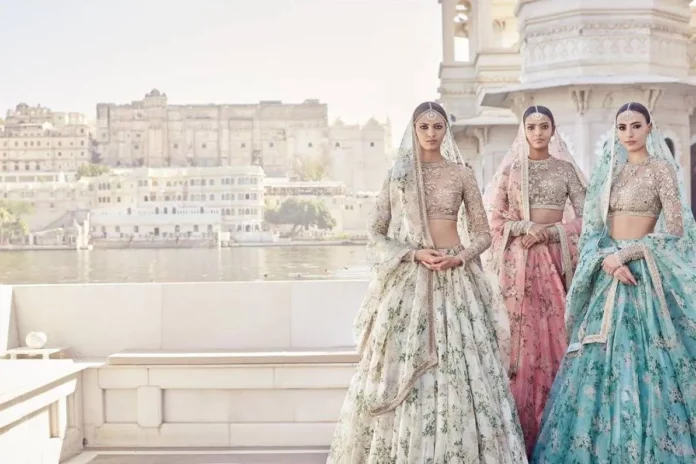Trending Bridal Lehenga Embroidery
Every bride wants to enter her wedding wearing a dress that is incredibly magnificent, attractive, and lovely. In India, the majority of brides favour wearing lehengas with zari bridal lehenga embroidery. The choli, dupatta, and skirt of bridal lehengas are richly embellished, most often with embroidery work. The overall appeal of each bride is undoubtedly enhanced by her lehengas, which can range from modest to intricate in their threadwork. Here’s something wonderful for future brides who are ready to shop for their bridal lehengas.
Gota Pati
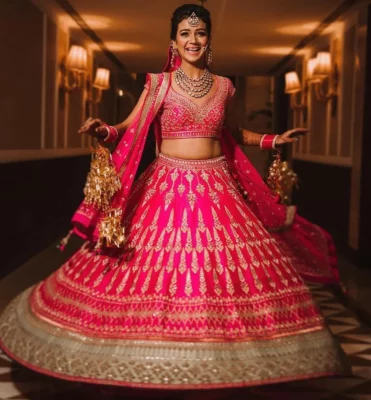
Image Source- Pinterest
A traditional Rajasthani method of embellishing clothing that draws its inspiration from the Mughal era is called gota patti. It can be made with gold and copper fibres and has a bridal appeal. This metallic embroidery can either be applied directly to the fabric or used as an appliqué. When done on materials like georgette, chiffon, velvet, and silk, gota work is at its most exquisite. With textiles in jewel tones, this gota’s golden appeal looks stunning.
Phulkari
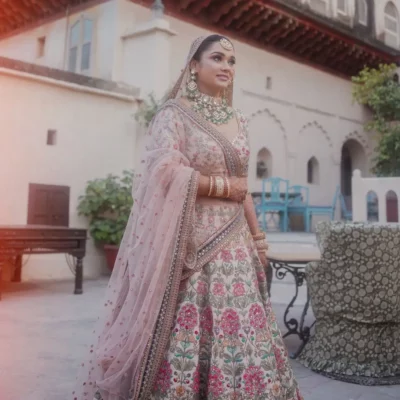
Image Source- Pinterest
Phulkari, which translates to “flower labour,” has a close connection to the Punjab region. This type of embroidery, which was spun on a charkha, was previously only used on items like shawls and dupattas, but brides are now incorporating it all over their lehengas. This embroidery is made with a silken thread on the cloth’s “wrong” side, which ultimately brings out the best in the “right” side of the fabric. The use of vivid silk threads and shading techniques draws attention to the lovely aspects of gardens.
Zari
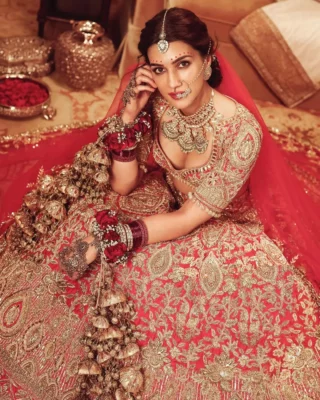
Image Source- Pinterest
By producing intricate designs and beautiful clothes, zari embroidery combines meaning and beauty. The delicate threadwork used in this traditional Indian embroidery is made using priceless gold and silver strands. This technique, which is typically applied to silk fabric, provides the garment a priceless appeal and raises its market worth. Modern zari can be used on textiles like georgette and chiffon since it resists rust and is therefore fairly durable. Because this embroidery work is not extremely dense, summer bridal lehengas make excellent use of it.
Dabka
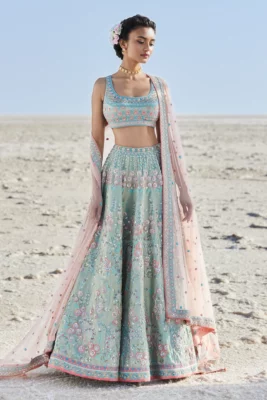
Image Source- Pinterest
A method used in dabka needlework includes coiling a wire to produce elaborate designs that resemble springs. High levels of attention to detail and exact designs are required for this meticulous needlework method. A cotton thread is used to build the embroidery’s foundation before a metal coil is placed on top of it. This needlework, which is typically done on chiffon, has a 3D effect. Once more, a popular option for brides who appreciate exquisite craftsmanship yet prefer lightweight work on their attire.
Chikankari
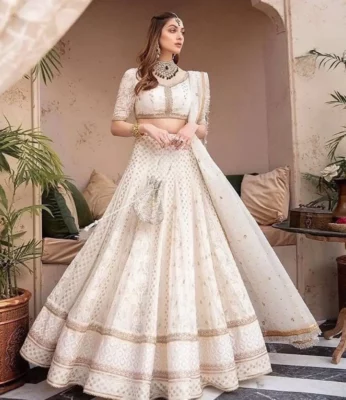
Image Source- Pinterest
Chikankari, an ancient and well-known kind of art from Lucknow, is an embroidery. The cloth has a subtle yet elegant appeal because to the modest and accurate handwork on it. The main focus of this needlework is simplicity, but the finished product has a rich appearance. The distinctive and conspicuous use of floral motifs, such as Booti, Paisley, etc., in this trade is a result of the influence of Persian aesthetics. Ivory and beige are neutral and simple colours that this embroidery style looks best on. Cut dana and sequins are combined with chikankari to give it a bridal appearance.
Cut Dana
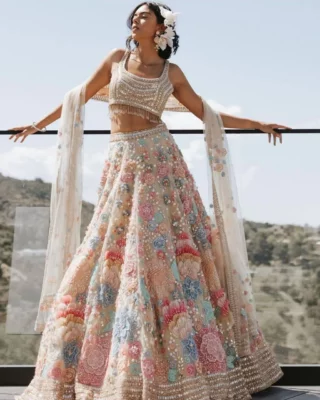
Image Source- Pinterest
Stones and beads are used to create cut dana work. In order to reflect light, the raw material is chopped into particular shapes and sizes. Barrel and tubular shapes are most frequently employed. To get the required pattern, they are combined in various ways. To give it a wedding appearance, these are sewed into the fabric. They can be fashioned of a variety of colours and decorated with glaze, lustre, and coatings. Combining cut dana with thread embroidery in complimentary colours is another method to improve it.
Zardosi
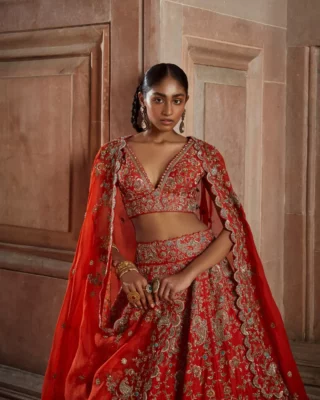
Image Source- Pinterest
A more refined, intricate, and elaborate variation of zari stitching is zardozi. On heavy silk, velvet, and satin materials, precious pearls, beads, and gota pattis are carved with beautiful gold threads. On a wooden framework, zardozi embroidery is constructed using a variety of instruments, including needles, gold wires, metal stars, sequins, beads, thread, etc. To make a thick lehenga, it can be combined with different kinds of embroidered work.
Mirror Work
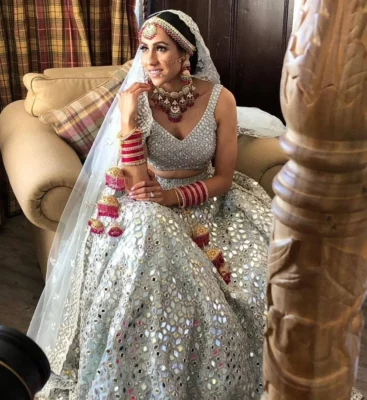
Image Source- Pinterest
Small mirrors are attached and given a casing in shisha, or mirrorwork embroidery. These mirrors are set with special cross-stitched embroidery, enhancing the look of the clothing. Mirrors of a variety of shapes—including polygonal, hexagonal, square, triangular, and circular—are used to make patterns. Most Rajasthani and Gujarati bridal lehengas include this design.
Applique
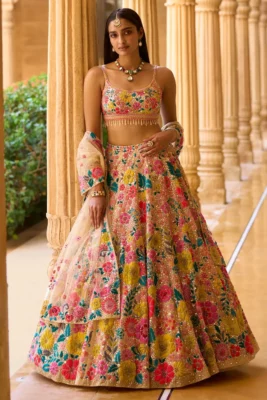
Image Source- Pinterest
This type of embroidery involves applying or sewing a patch or a piece of cloth to the fabric or the garment. Despite having its origins in the French fashion industry, this look has been very popular among Indian brides. A finely selected piece of fabric is applied to another fabric using a special kind of embroidery to give it a 3D appearance.
Gara
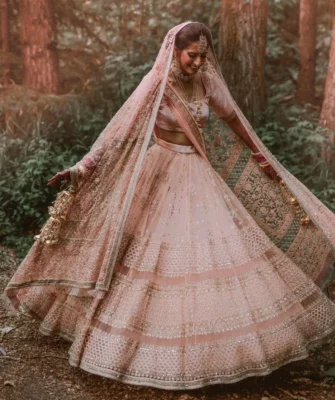
Image Source- Pinterest
Although it can also be found in contemporary bridal lehengas, gara embroidery is a traditional design feature favoured by Parsi brides. The typical attire for Parsi brides is a saree embroidered with exquisite designs like roses, lotuses, roosters, and peacocks. This type of embroidery work has a rich elegance, which is why it is referred to as an underappreciated Indian art form. If you want to tailor your bridal attire, you should definitely take this style into consideration.
Anyone’s inner bridezilla can be triggered by bridal lehenga shopping. But if you end up with a design and embroidery job that you really like, it will be worth the time and effort. Ask for a specific embroidery style you like when you visit a store, or find out if they can alter the design to suit your tastes. The important thing is to look at bridal lehengas as soon as you can. We hope you will make the most of the lovely embroideries on your bridal attire to convey a feeling of royalty.





